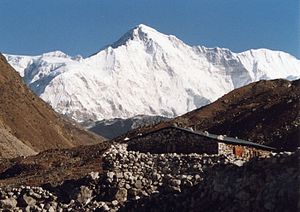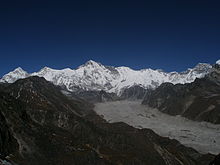Cho Oyu
| Cho Oyu | ||
|---|---|---|
|
The south face of Cho Oyu from Gokyo from |
||
| height | 8188 m | |
| location | Solukhumbu District ( Nepal ), Tibet ( PR China ) |
|
| Mountains | Mahalangur Himal ( Himalaya ) | |
| Dominance | 29.05 km → Mount Everest | |
| Notch height | 2340 m ↓ ( 5848 m ) | |
| Coordinates | 28 ° 5 '38 " N , 86 ° 39' 39" E | |
|
|
||
| First ascent | October 19, 1954 by Herbert Tichy , Josef Jöchler and Pasang Dawa Lama | |
| Normal way | Northwest side | |
|
North side of Cho Oyu from Tingri of view |
||
Cho Oyu or Qowowuyag ("goddess of turquoise"; Tibetan ཇོ་ བོ་ དབུ་ ཡ Wylie jo-bo-dbu-ya ; Chinese 卓奥 友 山 , Pinyin Zhuó'àoyǒu Shān , Nepali चो ओयु Cho Oyu ) is an eight-thousander in the Himalayas . It is located in the central Himalayas only 20 km west of Mount Everest and Lhotse and represents the western cornerstone of the Mahalangur Himal in the main Himalayan ridge. The border between China and Nepal runs over the summit of Cho Oyu.
Surname
The name "goddess of turquoise" refers to the turquoise glow of the summit in the afternoon light that is visible from Tibet. The name is probably composed of the Tibetan words chomo ("goddess") and yo ("turquoise"), but this derivation has not been proven. First to climb Herbert Tichy found out from a lama in Namche Bazar that the name means "mighty head". Heinrich Harrer suspects that the mountain is called cho-iu (“God's head”); on earlier maps the mountain was phonetically similar to Cho Uyu. An alternative Tibetan translation of the name ("bald god") coincides with Harrer's version and with a legend according to which the bald god Cho Oyu turned his back on the goddess mother Chomolungma because she refused to marry him.
height
The Cho Oyu was only recognized as the sixth highest of the 14 eight-thousanders thanks to a new survey in 1984 . Until then it had taken eighth place with a supposed height of 8153 m behind Dhaulagiri ( 8167 m ) and Manaslu ( 8163 m ). After the survey in 1984, its altitude was initially set at 8201 m and, after more recent measurements, corrected to 8188 m in the 1990s .
Ascent history
First ascent
Because the Swiss had anticipated the British in obtaining approval for Mount Everest in 1952 , the British concentrated this year on Cho Oyu, where the participants of the Everest expedition, which had already been approved for 1953, tested their equipment and altitude adjustment. Edmund Hillary and George Lowe explored the northwest accesses of Cho Oyu, the south side was considered unassailable. An attempt to climb from the north was not made because expedition leader Eric Shipton did not dare to set up a chain of camps across the border into forbidden Tibet.
On October 19, 1954, a small Austrian expedition led by Herbert Tichy - with the Tyrolean Sepp Jöchler and the Sherpa Pasang Dawa Lama - managed the first ascent of the mountain without additional oxygen. The way to the north side over an icefall had proven to be easier than the British feared two years earlier.
Further ascents
In 1958 an Indian expedition made the second ascent. In the same year there was also the first death on Cho Oyu. The Sherpa Pasang Dawa Lama climbed the summit for the second time. The mountaineers Pasang and Sonam Gyaltsen were received by Indian Prime Minister Nehru in New Delhi; They were also celebrated in Kathmandu, because for the first time on an expedition the Sherpa alone came to the summit. The third ascent by a German expedition in 1964 is still controversial today as there is no evidence of reaching the summit. Fritz Stammberger had stated that he reached the summit alone after his Sherpa stayed 150 meters below the summit. The evidential value of the alleged summit photo was then disputed.
In 1978 the Austrian alpinists Edi Koblmüller and Alois Furtner climbed the extremely difficult and dangerous southeast face to the summit. In 1983 the South Tyrolean Reinhold Messner, together with Michl Dacher and Hans Kammerlander, achieved the fourth documented ascent. They climbed in alpine style on a new route from the southwest ridge through the southwest face to the summit. By this time, eight people, including the well-known German mountaineer Reinhard Karl , had died in an unsuccessful ascent of Cho Oyu in 1982 . In 1985 Maciej Berbeka and Maciej Pawlikowski from a Polish expedition led by Andrzej Zawada made the first winter ascent over the south pillar, which is still considered the most difficult route to this day. A few days later, with Jerzy Kukuczka and Andrzej Heinrich, two other expedition members were successful.
The first ascent of a women's team was achieved by Czechoslovakian Dina Štěrbová and American Vera Komarkova together with Ang Rita Sherpa and Nuru Sherpa on May 13, 1984.
In 1988 a Slovenian team climbed the north face for the first time. The southwest face was first climbed in 1990 by Wojciech Kurtyka , Erhard Loretan and Jean Troillet . In 1996 the Spaniard Òscar Cadiach and the Austrian Sebastian Ruchsteiner climbed the north ridge for the first time. The Austrian Stefan Gatt and the French Marco Siffredi were the first to ski the mountain in 1999 and 2000 respectively. The Kazakhs Boris Dedeshko and Denis Urubko managed a direct route in the southeast face in 2009. This first ascent was honored with the Piolet d'Or .
Ascent statistics
After Mount Everest, Cho Oyu is the most climbed eight-thousander with 2790 summit successes (as of June 30, 2009). On his normal route he is one of the "easier" eight-thousanders with few objective difficulties. Therefore, it is often the target of commercial expeditions and has the lowest risk of all eight-thousanders with a ratio of one death to 65 summit successes.
Commercial expedition companies that organize an ascent of Everest therefore often recommend customers who are inexperienced in extreme altitudes to take part in an expedition to Cho Oyu beforehand. In addition to the commercial interest, a walk on the Cho Oyu offers everyone involved an opportunity to assess their individual adaptability to high altitudes and lack of oxygen.
Artistic reception
In September and October 2001, the Norwegian mountaineer and ambient artist Geir Jenssen climbed the mountain and made field recordings of the sounds of nature and surroundings during the ascent . The recordings were released in 2006 under the title Cho Oyu 8201m - Field Recordings From Tibet .
literature
- Herbert Tichy : Cho Oyu - grace of the gods . Ullstein, Vienna 1955.
- Toni Hiebeler: Mountains of our earth . Süddeutscher Verlag, Stuttgart 1974.
- Karl Ziak : Man and the mountains . Verlag Das Bergland-Buch, Salzburg 1983.
- Fritz Rudolph: Chomolungma and her children . Sportverlag, Berlin 1986, ISBN 3-328-00125-5 .
- Steve Razzetti, Victor Saunders: Nepal. Trekking and climbing . Interlink Pub, London 1998.
- Reinhold Messner : Cho Oyu - goddess of turquoise. Malik, Munich 2012, ISBN 978-3-89029-417-9 .
- Hans Dieter Sauer: The Challenge - Going it alone on the Cho Oyu , Bruckmann Verlag, Munich 2004, ISBN 3-7654-4144-9 .
Individual evidence
- ↑ Richard Sale, John Cleare: On Top of the World. The 14 eight-thousanders: from the first ascent to the present day. BLV, Munich 2001, p. 102.
- ↑ Cho Oyu at www.8000ers.com , accessed November 17, 2012.
- ^ Günter Oskar Dyhrenfurth: The third pole. The eight-thousanders and their satellites. Book guild Gutenberg, Frankfurt am Main 1961, p. 64.
- ^ Günter Oskar Dyhrenfurth: The third pole. The eight-thousanders and their satellites. Book Guild Gutenberg, Frankfurt am Main 1961, pp. 76–78.
- ^ Günter Oskar Dyhrenfurth: The third pole. The eight-thousanders and their satellites. Book guild Gutenberg, Frankfurt am Main 1961, p. 88.
- ^ OV: Cho Oyu. In: American Alpine Journal. 1965, p. 463 (AAJO), accessed November 17, 2012.
- ^ OV: False or Doubtful Claims of Ascents in 1964. In: American Alpine Journal. 1966, p. 199, accessed November 17, 2012.
- ↑ a b Rollo Steffens: Cho Oyu - The Goddess of Turquoise ( Memento from February 11, 2013 in the web archive archive.today ) on: www.rollo-steffens.de , accessed on November 17, 2012.
- ↑ Michael J. Cheney, Elizabeth Hawley: Cho Oyu. In: American Alpine Journal. 1983, p. 243, accessed November 17, 2012.
- ^ Fatalities - Cho Oyu. at: www.8000ers.com , accessed November 17, 2012.
- ↑ Andrzej Zawada: The First Winter Ascent of Cho Oyu (1984–1985). In: Alpine Journal. 1988-1989, pp. 41-47. (PDF; 3.1 MB), accessed on November 17, 2012.
- ↑ Vera Kormanova: Cho Oyu. In: American Alpine Journal. 1985, pp. 89–93 (AAJO) (PDF; 961 kB), accessed on November 17, 2012.
- ↑ a b c d Reinhold Messner: Survived - My 14 eight-thousanders Malik / National Geographic, Munich 2013, p. 288.
- ^ Trey Cook: The Disappearance Of Marco Siffredi. snowboarding.transworld.net, September 8, 2013, accessed on August 16, 2017 .
- ↑ a b See Nations statistics and Fatalities table , accessed February 12, 2010.
- ^ For example, the expedition provider Alpine Ascents , accessed on November 17, 2012.
- ↑ Geir Jenssen: Cho Oyu 8201 m - Field Recordings From Tibet. Review on www.ikonen-magazin.de, accessed on November 17, 2012.
Web links
- Cho Oyu on Peakbagger.com (English)
- Cho Oyu on GeoFinder.ch
- Cho Oyu at himalaya-info.org
- Photos from the first ascent of Cho Oyu ( Memento from November 1, 2014 in the Internet Archive )




